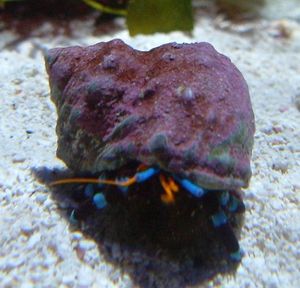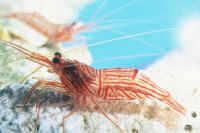Salt Water Tank Clean-up Crew
A clean-up crew for your salt water tank is a natural way to help keep your tank clean.
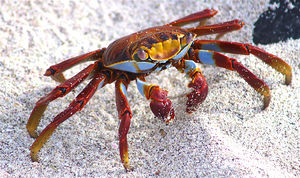
By selecting a crew appropriate to your tank and maintenance needs, you can greatly simply your weekly maintenance schedule. Most of the animals in a clean-up crew work around the clock grazing on algae or sifting the sand. Due to the small size of most of the animals they can frequently reach areas too small for an aquarist to get their hands or tools into.
Contents
3 Steps to a clean-up crew[edit]
- Identify what you need to clean in your tank. Are you trying to get rid of algae, trying to keep your sand bed turned, or perhaps trying to get rid of unwanted pests
- Pick out animals suited for your tank. Our Salt Water Tank Clean-up Crew Animals article can help guide you in the right direction.
- Introduce the animals and watch the pests get cleaned up.
Why do I need a clean-up crew for my tank?[edit]
A good clean-up crew provides many healthy benefits to your tank and will help you maintain a better water quality.
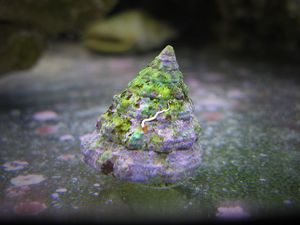
Some of the prime benefits include:
- Consuming excess food missed by your livestock
- Eating detritus
- Eating many varieties of algae, including many nuisance strains
- Turning the sand bed
Every fish-keeper should know that you should generally only feed your fish what they can eat in 30 seconds to 1 minute, once or twice a day. The main purpose of this rule is to keep excess food from decaying on the bottom of your tank. A good clean-up crew can help to easily mitigate this issue. Almost all of the animals common to clean-up crews will eat fallen food, as such it is not typically necessary get a specific animal to eat fallen food.
Detritus, one of the last stages of decay in the tank, is a common issue in many tanks. It is generated as left-over foods and fish waste decay. Uncontrolled, either by clean-up crew or weekly maintenance, detritus will quickly build up in a tank. The detritus munching members of your clean-up crew will help you by converting this substance into a smaller material. Your tank's bacteria colony will continue the decomposition if it is not manually removed from the tank.
Algae is a constant scourge of any fish tank. Luckily there are a plethora of algae eating clean up crew members, many of which specialize in nuisance algae control. Algae control is typically the primary mission of any clean-up crew. This is because it is difficult, and dangerous for your livestock, to remove algae from live rock by hand. A shifting rock could damage coral or kill a hiding animal, our clean-up crew will typically have a more gentle hand. You will likely get most of your clean-up crew for the purpose of algae control, and you would be wise to ensure you have at least one member that can target each algae type.
Turning the sand bed is a maintenance chore for tanks with a deep sand bed. This activity helps prevent an anaerobic sand bed. It is possible to get clean-up crew members to help with this task. Many of these animals will also sift the sand for food, helping to keep it looking its best.
What animals should I choose to clean my tank[edit]
There are many animals to choose from when building a clean-up crew. Our Salt Water Tank Clean-up Crew Animals article provides a convenient matrix of animals with their jobs. All too often however you will be limited to your store's local availability. Please ensure you read the profile information for each species to ensure they are a good fit for your tank.
How many should I get?[edit]
Anyone who tells you that you need X of species Y is selling you something. There is no magic number of snail, crabs, and others required for a given size tank. The size of your clean-up crew is dependent on many factors in your tank.
Commonly cited general numbers are 1 snail per gallon and 1 crab per four gallons[1]. This rule of thumb should be taken with a grain of salt, and should be balanced with the knowledge that snails, crabs, and other members of your clean-up crew add to your tank's bio-load.
For this reason it is strongly recommend that you ramp up your clean-up crew population as your tank matures. A new tank will need a clean-up crew consisting mostly of algae munchers, simply cleaning the algae growing from your light source. As your tank matures your stocking choices will influence how you evolve your clean-up crew makeup.
Aquascaping and your clean-up crew[edit]
How your tank is set-up will effect what your clean-up crew needs to focus on. Do you have a large spacious swimming area with a sand bed? You may need more members working on filtering the sand. If you have intricate rock work that is balanced and not well secured? You will want to avoid some of the larger snails that are capable of rearranging your rocks.
Each tank will be different and we strongly encourage you to seek specific help from your favorite aquarium community when designing your clean-up crew. Keep in mind though, your mileage with a specific species WILL very, so what works for one person may not work for another.
Ongoing maintenance for your crew[edit]
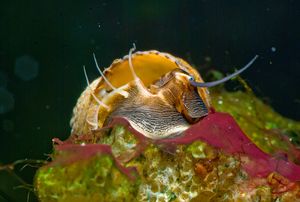
Like everything in your tank, the clean-up crew will require maintenance as well. This can be done less frequently than most aquarium maintenance tasks, but should be something you always keep in mind when looking at your tank.
Replacing losses[edit]
It is inevitable that members of your clean-up crew will die. They may die either naturally or they may become a snack for another member of your tank. Either way, their loss must be compensated for or your tank may begin to lose the war on algae.
Fine tuning your clean-up crew[edit]
It is important at you observe your tank frequently. If you know your tank, you will know when something is wrong and it will make correcting the issue that much easier because you catch the problem sooner.
Fine tuning your crew primarily refers to adding animals to your tank to compensate for new algae or pest growth. Check out Salt Water Tank Clean-up Crew Animals to match your issue with a clean-up crew member.